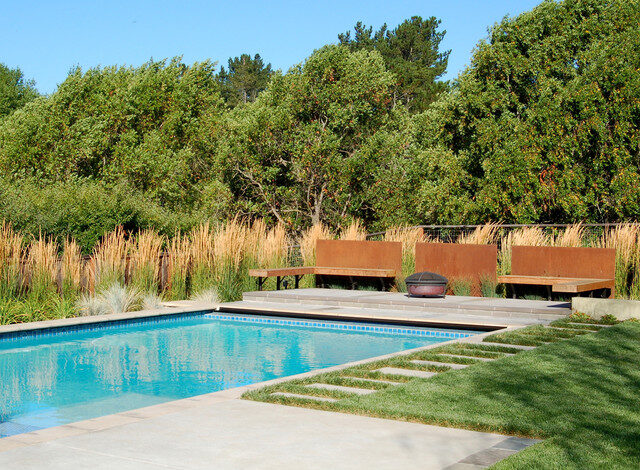Feather Reed Grass

Discover the beauty and versatility of feather reed grass, a popular ornamental grass ideal for various landscapes. Learn how to plant, care for, and design with feather reed grass in your garden.
Introduction to Feather Reed Grass
Feather reed grass, known botanically as Calamagrostis x acutiflora, is a popular ornamental grass cherished for its striking vertical presence and versatile uses in landscaping. This grass, native to Europe and Asia, has been a staple in gardens worldwide due to its elegant appearance and easy maintenance. The history of feather reed grass dates back to its first use in traditional European gardens, where it was valued for its ornamental qualities and ability to thrive in diverse conditions.
Characteristics of Feather Reed Grass
Feather reed grass is characterized by its tall, slender stems that can reach heights of up to six feet, topped with feathery plumes that change color throughout the seasons. It has a clumping growth habit, making it ideal for creating vertical interest in garden beds. The grass typically flowers from late spring to early summer, producing delicate, airy inflorescences that transition from green to golden brown as they mature. This seasonal transformation adds dynamic visual interest to any landscape.
Popular Varieties of Feather Reed Grass
Several varieties of feather reed grass are particularly popular among gardeners. The ‘Karl Foerster’ variety is the most well-known, appreciated for its upright growth and early flowering. ‘Overdam’ is another favorite, distinguished by its variegated foliage with creamy white stripes. ‘Avalanche’ is similar to ‘Overdam’ but features a broader white stripe down the center of each leaf, adding a striking contrast to garden plantings.
Planting Feather Reed Grass
When planting feather reed grass, site selection is crucial for its success. Choose a location with full sun to partial shade and well-drained soil. Feather reed grass can tolerate a range of soil types but thrives best in moderately fertile soil. Planting is best done in spring or early fall to allow the grass to establish roots before extreme weather conditions set in. Dig a hole twice the width of the root ball, place the plant in the hole, and backfill with soil, ensuring the crown is level with the soil surface.
Caring for Feather Reed Grass
Caring for feather reed grass involves regular watering, especially during its first growing season to establish a robust root system. Once established, it is relatively drought-tolerant. Fertilize in early spring with a balanced fertilizer to promote healthy growth. Pruning should be done in late winter or early spring before new growth begins. Cut back the old stems to about 6 inches above the ground to make way for fresh shoots.
Propagation of Feather Reed Grass
Feather reed grass can be propagated through seeds or division. Seed propagation involves collecting seeds from mature plants and sowing them in a seed-starting mix. However, division is the most reliable method. Every three to four years, divide the clumps in early spring or late fall. Dig up the entire clump, separate it into smaller sections with roots attached, and replant them in prepared soil.
Pest and Disease Management
Feather reed grass is relatively pest-resistant but can occasionally be affected by aphids or spider mites. Regular inspection and the use of insecticidal soap can help manage these pests. Disease prevention primarily involves ensuring proper air circulation around the plants and avoiding waterlogged soil. If fungal issues arise, treat with appropriate fungicides and improve drainage.
Feather Reed Grass in Landscape Design
Feather reed grass is a versatile plant in landscape design. It can be used as a focal point in garden beds, a backdrop for flowering perennials, or to create natural privacy screens. Its vertical growth habit complements both formal and informal garden styles. Pairing it with plants like sedum, echinacea, and rudbeckia enhances its visual appeal and creates a balanced garden design.
Benefits of Feather Reed Grass
The benefits of feather reed grass extend beyond its aesthetic appeal. It is an excellent choice for erosion control on slopes due to its deep root system. This grass also supports local wildlife by providing habitat and food sources for birds and insects. Additionally, its low maintenance requirements make it an eco-friendly option for sustainable gardening practices.
Challenges with Feather Reed Grass
While feather reed grass is generally easy to grow, it can face some challenges. Overly wet conditions can lead to root rot, and heavy clay soils may require amending to improve drainage. Additionally, it can become invasive if not properly managed, so regular monitoring and maintenance are essential. Ensuring the right growing conditions and proactive care can mitigate these issues.
Seasonal Care for Feather Reed Grass
Seasonal care for feather reed grass involves specific tasks throughout the year. In spring, prune back old growth and apply fertilizer. During the summer, ensure adequate watering, especially in dry periods. Fall is the time to clean up any dead foliage and prepare the plant for winter by mulching around the base. Winter care is minimal, but protecting young plants from extreme cold with additional mulch can be beneficial.
Feather Reed Grass in Different Climates
Feather reed grass is highly adaptable and can thrive in various climates. It is cold-hardy and can withstand freezing temperatures, making it suitable for northern gardens. In warmer climates, it may require additional water during prolonged dry spells. Its versatility makes it a reliable choice for gardeners in diverse regions.
Combining Feather Reed Grass with Other Plants
Combining feather reed grass with other plants can create stunning garden displays. It pairs well with low-growing perennials, such as salvia and lavender, which contrast nicely with its tall, upright form. Mixing it with colorful annuals or bulbs can add seasonal interest and diversity to your garden.
Feather Reed Grass in Container Gardening
Feather reed grass can also be grown in containers, providing flexibility for small spaces or patios. Choose a large pot with good drainage and fill it with a high-quality potting mix. Regular watering and feeding are essential for container-grown plants. This approach allows gardeners to enjoy the beauty of feather reed grass even in limited spaces.
Pruning and Dividing Feather Reed Grass
Pruning feather reed grass involves cutting back the old growth in late winter or early spring to promote new shoots. Dividing the grass every few years helps maintain its vigor and prevent overcrowding. This process not only rejuvenates the plant but also allows you to propagate new plants for other areas of your garden.
Feather Reed Grass for Erosion Control
Feather reed grass is effective for erosion control due to its extensive root system, which stabilizes soil and prevents runoff. Planting it on slopes or embankments can reduce soil erosion and improve the overall health of the landscape. Case studies have shown its success in various erosion-prone areas, making it a valuable addition to sustainable landscaping projects.
Decorative Uses of Feather Reed Grass
Beyond its use in the garden, feather reed grass has decorative applications. Its tall, feathery plumes make excellent cut flowers for fresh or dried arrangements. They can be used in bouquets, wreaths, or as standalone decorative elements in the home, adding a touch of natural elegance.
Feather Reed Grass in Sustainable Gardening
Feather reed grass is an ideal plant for sustainable gardening. Its drought tolerance reduces water usage, and its deep roots improve soil structure and fertility. Additionally, it provides habitat for beneficial insects and birds, supporting biodiversity. Incorporating feather reed grass into your garden can enhance its ecological value and sustainability.
Economic Importance of Feather Reed Grass
The economic importance of feather reed grass lies in its commercial uses and market demand. It is widely used in landscaping due to its low maintenance and aesthetic appeal. The nursery industry benefits from its popularity, with many growers producing a variety of cultivars to meet market needs. Its role in urban and residential landscaping contributes significantly to the horticulture economy.
Choosing the Right Feather Reed Grass for Your Garden
Choosing the right feather reed grass for your garden involves considering factors such as climate, soil type, and garden design. Popular choices like ‘Karl Foerster’ and ‘Overdam’ offer different visual effects and growth habits. Consulting with local garden centers or landscape professionals can help you select the best variety for your specific needs.
Growing Feather Reed Grass from Seed
Growing feather reed grass from seed requires patience and attention to detail. Collect seeds from mature plants in late summer and sow them in a seed-starting mix. Maintain consistent moisture and provide adequate light for germination. Transplant the seedlings into the garden once they are large enough to handle, typically after the last frost date.
Feather Reed Grass in Public Spaces
Feather reed grass is commonly used in public spaces for its resilience and visual impact. Urban landscapes, parks, and roadside plantings benefit from its low maintenance and adaptability. It can enhance the aesthetic value of public areas while providing functional benefits like erosion control and habitat for urban wildlife.
Environmental Impact of Feather Reed Grass
The environmental impact of feather reed grass is largely positive. It contributes to soil health by improving structure and reducing erosion. Its ability to sequester carbon makes it a valuable plant for mitigating climate change. Additionally, it supports local ecosystems by providing food and shelter for various wildlife species.
Feather Reed Grass in Different Soil Types
Feather reed grass is adaptable to a variety of soil types but performs best in well-drained, moderately fertile soils. Sandy or loamy soils are ideal, while heavy clay may require amendments to improve drainage. Regular soil testing and appropriate amendments can optimize growing conditions and enhance plant health.
Feather Reed Grass in Wildlife Gardens
Feather reed grass is a beneficial addition to wildlife gardens. Its tall stems and dense foliage provide shelter for birds and small mammals. The grass also attracts pollinators such as butterflies and bees, contributing to the ecological health of your garden. Planting feather reed grass can create a thriving habitat for local wildlife.
Feather Reed Grass in Xeriscaping
Feather reed grass is well-suited for xeriscaping due to its drought tolerance and low water requirements. Incorporating it into water-wise garden designs can reduce irrigation needs and promote sustainable landscaping practices. Its architectural form and seasonal interest make it an attractive choice for xeriscaped gardens.
Common Myths about Feather Reed Grass
There are several common myths about feather reed grass that need debunking. One myth is that it requires constant watering; in reality, it is quite drought-tolerant once established. Another misconception is that it cannot grow in poor soils, but it can thrive in a range of soil conditions with proper care. Understanding the true characteristics of feather reed grass can help gardeners make informed decisions.
Historical Significance of Feather Reed Grass
The historical significance of feather reed grass is rooted in its use in traditional European gardens. It has been valued for centuries for its ornamental qualities and versatility. Historical records indicate its use in early landscape designs, reflecting its enduring appeal and adaptability.
Feather Reed Grass in Art and Culture
Feather reed grass has found its way into art and culture, symbolizing grace and resilience. Artists have depicted it in paintings and botanical illustrations, capturing its delicate beauty. In modern culture, it is often used in landscape photography and garden design, showcasing its timeless elegance.
Frequently Asked Questions about Feather Reed Grass
What is the best time to plant feather reed grass?
The best time to plant feather reed grass is in spring or early fall when the weather is mild, and the soil is workable.
How often should I water feather reed grass?
Water feather reed grass regularly during its first growing season. Once established, it is relatively drought-tolerant and requires less frequent watering.
Can feather reed grass be grown in containers?
Yes, feather reed grass can be grown in containers. Choose a large pot with good drainage and ensure regular watering and feeding.
How do I prune feather reed grass?
Prune feather reed grass in late winter or early spring by cutting back the old stems to about 6 inches above the ground.
Is feather reed grass invasive?
Feather reed grass can become invasive if not properly managed. Regular division and monitoring can help control its spread.
What are the common pests affecting feather reed grass?
Common pests include aphids and spider mites. Regular inspection and treatment with insecticidal soap can manage these issues.
Conclusion
Feather reed grass is a versatile and attractive addition to any garden, offering aesthetic appeal, environmental benefits, and low maintenance requirements. By understanding its characteristics, planting and care needs, and potential challenges, gardeners can successfully incorporate this beautiful grass into their landscapes. Whether used for erosion control, decorative purposes, or sustainable gardening, feather reed grass proves to be a valuable and rewarding choice.



